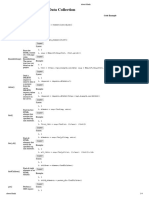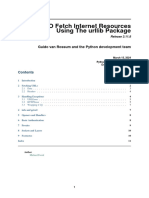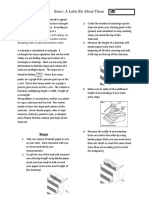11/8/25, 11:50 a.m.
about:blank
Cheat Sheet: API's and Data Collection
Package/Method Description Code Example
Syntax:
attribute = element[(attribute)]
Access the
value of a
Accessing specific
element attribute attribute of an Example:
HTML
element. href = link_element[(href)]
Syntax:
soup = BeautifulSoup(html, (html.parser))
Parse the
HTML content
of a web page
using
BeautifulSoup() BeautifulSoup.
The parser Example:
type can vary
html = (https://api.example.com/data) soup = BeautifulSoup(html, (html.parser))
based on the
project.
Syntax:
response = requests.delete(url)
Send a
DELETE
request to
remove data or
a resource
from the
delete()
server. Example:
DELETE
requests delete response = requests.delete((https://api.example.com/delete))
a specified
resource on
the server.
about:blank 1/6
11/8/25, 11:50 a.m. about:blank
Syntax:
element = soup.find(tag, attrs)
Find the first
HTML
element that
find()
matches the Example:
specified tag
and attributes. first_link = soup.find((a), {(class): (link)})
Syntax:
elements = soup.find_all(tag, attrs)
Find all
HTML
elements that
find_all()
match the Example:
specified tag
and attributes. all_links = soup.find_all((a), {(class): (link)})</td>
Syntax:
children = element.findChildren()
Find all child
elements of an
findChildren()
HTML Example:
element.
child_elements = parent_div.findChildren()
get() Perform a Syntax:
GET request
response = requests.get(url)
to retrieve data
from a
specified
about:blank 2/6
11/8/25, 11:50 a.m. about:blank
URL. GET
requests are
typically used
for reading
data from an
API. The
response
variable will
contain the Example:
server's response = requests.get((https://api.example.com/data))
response,
which you can
process
further.
Syntax:
headers = {(HeaderName): (Value)}
Include
custom
headers in the
request.
Headers can
provide
Headers additional
information to Example:
the server,
base_url = (https://api.example.com/data) headers = {(Authorization): (Bearer YOUR_TOKEN)} response = requests.ge
such as
authentication
tokens or
content types.
Syntax:
from bs4 import BeautifulSoup
Import the
necessary
Import Libraries Python
libraries for
web scraping.
json() Parse JSON Syntax:
data from the
data = response.json()
response. This
extracts and
works with the
data returned
by the API.
The
response.json()
method
converts the
JSON
response into a
Example:
Python data
structure response = requests.get((https://api.example.com/data))
(usually a data = response.json()
dictionary or
list).
about:blank 3/6
11/8/25, 11:50 a.m. about:blank
Syntax:
sibling = element.find_next_sibling()
Find the next
sibling
next_sibling()
element in the Example:
DOM.
next_sibling = current_element.find_next_sibling()
Syntax:
parent = element.parent
Access the
parent element
in the
parent
Document Example:
Object Model
(DOM). parent_div = paragraph.parent
Syntax:
response = requests.post(url, data)
Send a POST
request to a
specified URL
with data.
Create or
update POST
requests using
post() resources on
the server. The Example:
data parameter
response = requests.post((https://api.example.com/submit), data={(key): (value)})
contains the
data to send to
the server,
often in JSON
format.
put() Send a PUT Syntax:
request to
response = requests.put(url, data)
update data on
about:blank 4/6
11/8/25, 11:50 a.m. about:blank
the server.
PUT requests
are used to
update an
existing
resource on
the server with
the data
provided in the
data Example:
parameter,
typically in response = requests.put((https://api.example.com/update), data={(key): (value)})
JSON format.
Syntax:
params = {(param_name): (value)}
Pass query
parameters in
the URL to
filter or
customize the
Query parameters request. Query Example:
parameters
specify base_url = "https://api.example.com/data"
params = {"page": 1, "per_page": 10}
conditions or response = requests.get(base_url, params=params)
limits for the
requested data.
Syntax:
element = soup.select(selector)
Select HTML
elements from
select() the parsed
HTML using a Example:
CSS selector.
titles = soup.select((h1))
status_code Check the Syntax:
HTTP status
response.status_code
code of the
response. The
HTTP status
code indicates
the result of
about:blank 5/6
11/8/25, 11:50 a.m. about:blank
the request
(success, error,
redirection).
Use the HTTP
status codeIt
can be used for Example:
error handling
and decision- url = "https://api.example.com/data"
making in response = requests.get(url)
status_code = response.status_code
your code.
Tag Example:
- (a): Find anchor () tags.
- (p): Find paragraph ((p)) tags.
Specify any - (h1), (h2), (h3), (h4), (h5), (h6): Find heading tags from level 1 to 6 ( (h1),n (h2)).
valid HTML - (table): Find table () tags.
tag as the tag - (tr): Find table row () tags.
parameter to - (td): Find table cell ((td)) tags.
- (th): Find table header cell ((td))tags.
search for - (img): Find image ((img)) tags.
elements of - (form): Find form ((form)) tags.
tags for find()
that type. Here - (button): Find button ((button)) tags.
and find_all()
are some
common
HTML tags
that you can
use with the
tag parameter.
Syntax:
text = element.text
Retrieve the
text content of
text
an HTML Example:
element.
title_text = title_element.text
© IBM Corporation. All rights reserved.
about:blank 6/6





















































































